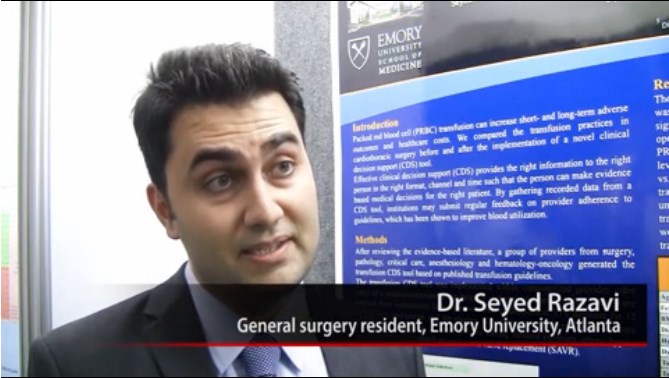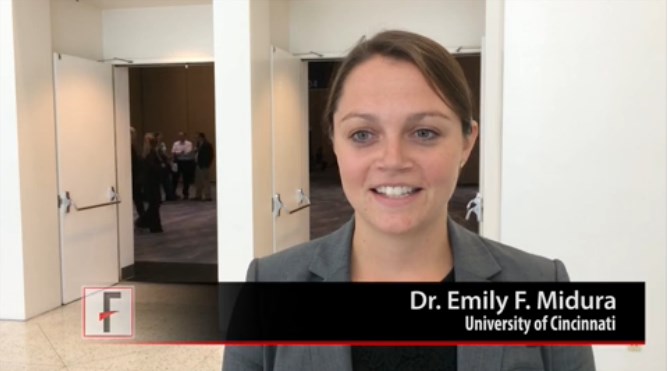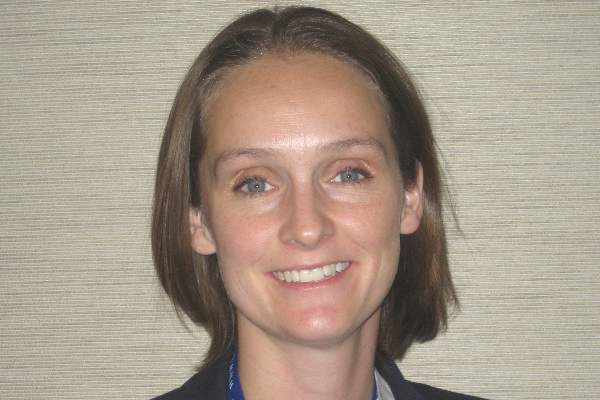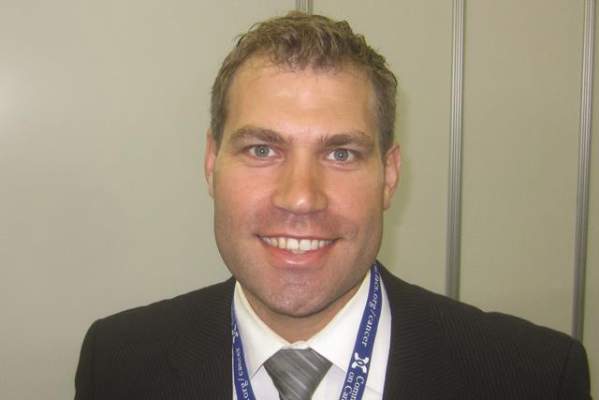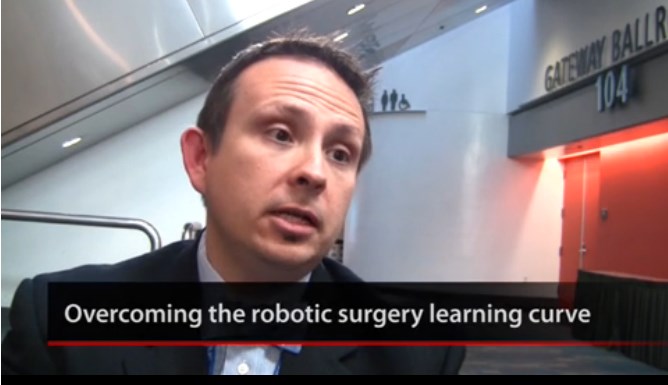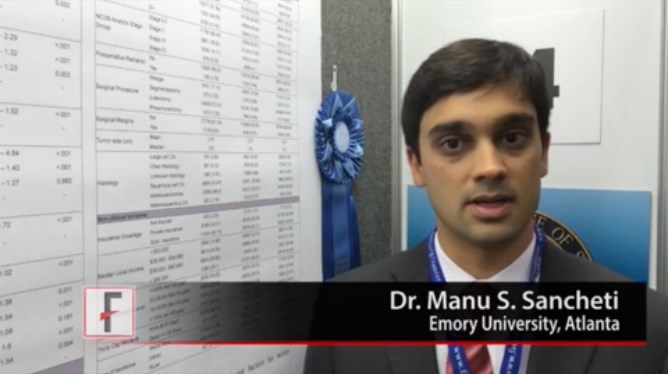User login
American College of Surgeons (ACS): Annual Clinical Congress
VIDEO: EMR reminder reduces unnecessary transfusions
SAN FRANCISCO – To reduce unnecessary transfusions, all it takes is a reminder in the electronic medical record system that they aren’t generally necessary if surgery patients have hemoglobins greater than 10 g/dL, according to investigators from Emory University in Atlanta.
A reminder in Emory’s EMR dropped transfusion rates in cardiothoracic patients without increasing negative outcomes. It also saved money and reduced the number of surgical site infections. Emory is now rolling it out systemwide (J. Am. Coll. Surg. 2014 June 25 [doi: 10.1016/j.jamcollsurg.2014.06.012]). Lead investigator Dr. Seyed Razavi explained the initiative in a video interview at the annual clinical congress of the American College of Surgeons.
The video associated with this article is no longer available on this site. Please view all of our videos on the MDedge YouTube channel
Dr. Hossein Almassi, FCCP, comments: By their nature, cardiac operations are associated with higher transfusion rates than other surgical procedures. The negative impact of blood transfusion on short term hospital outcomes and mortality is well known. Any effort in reducing the adverse outcomes is a step in the right direction, especially in this era of 'pay per performance". A "reminder in the EMR" is but one such step.
Dr. Almassi specializes in cardiothoracic surgery at the Medical College of Wisconsin in Milwaukee, Wisconsin.
Dr. Hossein Almassi, FCCP, comments: By their nature, cardiac operations are associated with higher transfusion rates than other surgical procedures. The negative impact of blood transfusion on short term hospital outcomes and mortality is well known. Any effort in reducing the adverse outcomes is a step in the right direction, especially in this era of 'pay per performance". A "reminder in the EMR" is but one such step.
Dr. Almassi specializes in cardiothoracic surgery at the Medical College of Wisconsin in Milwaukee, Wisconsin.
Dr. Hossein Almassi, FCCP, comments: By their nature, cardiac operations are associated with higher transfusion rates than other surgical procedures. The negative impact of blood transfusion on short term hospital outcomes and mortality is well known. Any effort in reducing the adverse outcomes is a step in the right direction, especially in this era of 'pay per performance". A "reminder in the EMR" is but one such step.
Dr. Almassi specializes in cardiothoracic surgery at the Medical College of Wisconsin in Milwaukee, Wisconsin.
SAN FRANCISCO – To reduce unnecessary transfusions, all it takes is a reminder in the electronic medical record system that they aren’t generally necessary if surgery patients have hemoglobins greater than 10 g/dL, according to investigators from Emory University in Atlanta.
A reminder in Emory’s EMR dropped transfusion rates in cardiothoracic patients without increasing negative outcomes. It also saved money and reduced the number of surgical site infections. Emory is now rolling it out systemwide (J. Am. Coll. Surg. 2014 June 25 [doi: 10.1016/j.jamcollsurg.2014.06.012]). Lead investigator Dr. Seyed Razavi explained the initiative in a video interview at the annual clinical congress of the American College of Surgeons.
The video associated with this article is no longer available on this site. Please view all of our videos on the MDedge YouTube channel
SAN FRANCISCO – To reduce unnecessary transfusions, all it takes is a reminder in the electronic medical record system that they aren’t generally necessary if surgery patients have hemoglobins greater than 10 g/dL, according to investigators from Emory University in Atlanta.
A reminder in Emory’s EMR dropped transfusion rates in cardiothoracic patients without increasing negative outcomes. It also saved money and reduced the number of surgical site infections. Emory is now rolling it out systemwide (J. Am. Coll. Surg. 2014 June 25 [doi: 10.1016/j.jamcollsurg.2014.06.012]). Lead investigator Dr. Seyed Razavi explained the initiative in a video interview at the annual clinical congress of the American College of Surgeons.
The video associated with this article is no longer available on this site. Please view all of our videos on the MDedge YouTube channel
AT THE ACS CLINICAL CONGRESS
VIDEO: Risks for anastomotic leak after colectomy identified
SAN FRANCISCO– A large retrospective study identified risk factors for anastomotic leak within 30 days of colectomy.
The analysis of data on 13,684 patients looked at a multicenter cohort, compared with previous smaller studies that generally focused on single institutions, Dr. Emily F. Midura and her associates reported at the annual clinical congress of the American College of Surgeons.
In a video interview at the meeting, Dr. Midura described the risk factors identified in the study.
The 4% of patients who developed a leak averaged 13 days in the hospital, compared with 8 days for patients with no leak, said Dr. Midura of the University of Cincinnati. A total of 6% of patients who developed an anastomotic leak died, compared with a 2% mortality rate in patients without a leak.
Indications for colectomy included cancer in 42% of patients, diverticulitis in 23%, inflammatory bowel disease in 6%, and other reasons in the rest of the cohort.
Dr. Midura reported having no financial disclosures.
The video associated with this article is no longer available on this site. Please view all of our videos on the MDedge YouTube channel
On Twitter @sherryboschert
SAN FRANCISCO– A large retrospective study identified risk factors for anastomotic leak within 30 days of colectomy.
The analysis of data on 13,684 patients looked at a multicenter cohort, compared with previous smaller studies that generally focused on single institutions, Dr. Emily F. Midura and her associates reported at the annual clinical congress of the American College of Surgeons.
In a video interview at the meeting, Dr. Midura described the risk factors identified in the study.
The 4% of patients who developed a leak averaged 13 days in the hospital, compared with 8 days for patients with no leak, said Dr. Midura of the University of Cincinnati. A total of 6% of patients who developed an anastomotic leak died, compared with a 2% mortality rate in patients without a leak.
Indications for colectomy included cancer in 42% of patients, diverticulitis in 23%, inflammatory bowel disease in 6%, and other reasons in the rest of the cohort.
Dr. Midura reported having no financial disclosures.
The video associated with this article is no longer available on this site. Please view all of our videos on the MDedge YouTube channel
On Twitter @sherryboschert
SAN FRANCISCO– A large retrospective study identified risk factors for anastomotic leak within 30 days of colectomy.
The analysis of data on 13,684 patients looked at a multicenter cohort, compared with previous smaller studies that generally focused on single institutions, Dr. Emily F. Midura and her associates reported at the annual clinical congress of the American College of Surgeons.
In a video interview at the meeting, Dr. Midura described the risk factors identified in the study.
The 4% of patients who developed a leak averaged 13 days in the hospital, compared with 8 days for patients with no leak, said Dr. Midura of the University of Cincinnati. A total of 6% of patients who developed an anastomotic leak died, compared with a 2% mortality rate in patients without a leak.
Indications for colectomy included cancer in 42% of patients, diverticulitis in 23%, inflammatory bowel disease in 6%, and other reasons in the rest of the cohort.
Dr. Midura reported having no financial disclosures.
The video associated with this article is no longer available on this site. Please view all of our videos on the MDedge YouTube channel
On Twitter @sherryboschert
AT THE ACS CLINICAL CONGRESS
Anticoagulants sharply increase hematoma risk after thyroid, parathyroid surgery
SAN FRANCISCO – Patients undergoing thyroid or parathyroid surgery have a sharply higher risk of postoperative hematoma if they are on clopidogrel or anticoagulants – even if these agents are stopped in advance – researchers reported at the annual clinical congress of the American College of Surgeons.
“Patients with multiple factors considered high risk for postoperative hematoma formation after parathyroid or thyroid surgery should probably undergo a period of observation,” recommended lead investigator Dr. Sarah C. Oltmann, who at the time of the study was the director of endocrine surgery at Parkland Memorial Hospital, University of Texas Southwestern Medical Center, Dallas.
“The need specifically for anticoagulation in the perioperative period should really be carefully assessed, and decisions regarding their use in the perioperative period need to be made very cautiously,” she added. “This is particularly important when considering the need for an injectable bridge [anticoagulant], and discussions with the patient’s primary care provider or cardiologist should be prompted because obviously a hematoma risk of 11% [seen with injectable anticoagulants] is not insignificant.”
The researchers retrospectively studied 4,514 patients who underwent thyroid or parathyroid surgery at the center between 1994 and 2013. Most of the operations were performed by high-volume surgeons.
Overall, 25% of patients were using an antiplatelet agent and 3% were using an anticoagulant agent, defined in the study as current use or use up to 5-7 days before surgery. “We felt that there may be some alteration of hemostasis both at the time of surgery and in the days following surgery if they were resumed on their home meds,” explained Dr. Oltmann, who is now a clinical instructor of surgery at the University of Wisconsin–Madison.
Overall, 0.5% of patients developed a postoperative hematoma, with the majority of these events occurring in the first 24 hours. Three-fourths of the affected patients had to undergo repeat surgery.
In multivariate analyses, clopidogrel (Plavix) users had 5.6 times the odds of developing a hematoma. But neither lower-dose aspirin (less than 325 mg daily) alone nor higher-dose aspirin alone was associated with this complication.
Hematoma odds were elevated by an even greater extent, 7.5 and 29.5 times, for patients using oral and injectable anticoagulants, respectively. (Subcutaneous heparin was not included among injectable anticoagulants because surgeons at the center seldom use it in this setting, according to Dr. Oltmann.)
Patients also had increased odds of hematoma if they underwent thyroid surgery as compared with parathyroid surgery (odds ratio, 7.9), and had a bilateral procedure as compared with a unilateral one (OR, 4.9).
“Additional studies are needed to better clarify both the risk-benefit ratio of injectable anticoagulation in this patient population and potentially being able to better risk-stratify which patients would be better served with a period of overnight observation,” Dr. Oltmann concluded.
Invited discussant Dr. Raymon H. Grogan, director of the endocrine surgery research program at University of Chicago Medicine, commented, “I think this work represents a level of detail and granularity in regard to anticoagulants that we haven’t seen before in this literature, so it’s really important for us to see these data.
“We tend to get lulled into a false sense of security when we talk about complications related to thyroidectomy because they are so rare. But the truth of the matter is that this is a complication that causes deaths. A recent Nationwide Inpatient Sample study showed that about 1.3% of people who developed a hematoma will actually die in the United States, which is not an insignificant number of people who will die from a complication that’s directly caused by something we’ve done as surgeons,” he said.
Patients often have other risk factors for hematoma, Dr. Grogan noted. Therefore, he wondered, “Who can actually be sent home as a same-day patient after thyroidectomy? … When you combine your … people on these medications, along with all these other risk factors, as well as the risk of significant hypocalcemia postop, it starts to get to the point where, is it really safe to send anyone home the same day after thyroidectomy, given this overwhelming number of different factors that could cause problems?”
“That’s something we all struggle with to a certain degree, trying to be able to best determine who is safe to go home at night and who is not,” Dr. Oltmann replied, noting that risk in the study was greatest for the small proportion of patients on anticoagulants. “So I think a patient who is on some form of anticoagulant, I would definitely have significant reservations about sending home on the same day. They would be somebody I would at least want to keep overnight.”
“As far as the other variables – Graves disease, the size of the tumor, some people would also argue smoking and poorly controlled hypertension – it really becomes a conversation between the surgeon and the patient to know how reliable is the patient, how do you feel the operation went. … Hopefully, the next step is being able to find a way to weigh these different factors to be able to figure out, well, if my patient has A, B, and C, I must observe versus if they don’t, this might be somebody I can send home.”
Another attendee asked, “How do you [handle] aspirin use, given that it’s low risk as seen in your data set? How do you preop the patients, [do you] ask them to stop any low-risk agents, such as aspirin, or if they take the combination of aspirin and Plavix, which one do you hold and which do you continue in your practice?”
“After kind of combing through this data and becoming very familiar with it, I feel very comfortable with continuing aspirin use through the perioperative period,” Dr. Oltmann commented.
“For Plavix, obviously, you just have to juggle the risk-benefit ratio of why they are on that medication,” she said. “I think the most compelling situation is for our patients with atrial fibrillation, with the primary care provider wanting to … have them done on a Lovenox [enoxaparin] bridge, and now having some sort of objective data to get back with them and say, ‘Listen, they have an 11% risk of this really bad complication. Do you really think their risk of stroke trumps that?’ In most patients, that’s not the case, and I think [these data are] finally going to be able to give us some ammunition in that particular battle.”
Dr. Oltmann disclosed that she had no relevant conflicts of interest.
SAN FRANCISCO – Patients undergoing thyroid or parathyroid surgery have a sharply higher risk of postoperative hematoma if they are on clopidogrel or anticoagulants – even if these agents are stopped in advance – researchers reported at the annual clinical congress of the American College of Surgeons.
“Patients with multiple factors considered high risk for postoperative hematoma formation after parathyroid or thyroid surgery should probably undergo a period of observation,” recommended lead investigator Dr. Sarah C. Oltmann, who at the time of the study was the director of endocrine surgery at Parkland Memorial Hospital, University of Texas Southwestern Medical Center, Dallas.
“The need specifically for anticoagulation in the perioperative period should really be carefully assessed, and decisions regarding their use in the perioperative period need to be made very cautiously,” she added. “This is particularly important when considering the need for an injectable bridge [anticoagulant], and discussions with the patient’s primary care provider or cardiologist should be prompted because obviously a hematoma risk of 11% [seen with injectable anticoagulants] is not insignificant.”
The researchers retrospectively studied 4,514 patients who underwent thyroid or parathyroid surgery at the center between 1994 and 2013. Most of the operations were performed by high-volume surgeons.
Overall, 25% of patients were using an antiplatelet agent and 3% were using an anticoagulant agent, defined in the study as current use or use up to 5-7 days before surgery. “We felt that there may be some alteration of hemostasis both at the time of surgery and in the days following surgery if they were resumed on their home meds,” explained Dr. Oltmann, who is now a clinical instructor of surgery at the University of Wisconsin–Madison.
Overall, 0.5% of patients developed a postoperative hematoma, with the majority of these events occurring in the first 24 hours. Three-fourths of the affected patients had to undergo repeat surgery.
In multivariate analyses, clopidogrel (Plavix) users had 5.6 times the odds of developing a hematoma. But neither lower-dose aspirin (less than 325 mg daily) alone nor higher-dose aspirin alone was associated with this complication.
Hematoma odds were elevated by an even greater extent, 7.5 and 29.5 times, for patients using oral and injectable anticoagulants, respectively. (Subcutaneous heparin was not included among injectable anticoagulants because surgeons at the center seldom use it in this setting, according to Dr. Oltmann.)
Patients also had increased odds of hematoma if they underwent thyroid surgery as compared with parathyroid surgery (odds ratio, 7.9), and had a bilateral procedure as compared with a unilateral one (OR, 4.9).
“Additional studies are needed to better clarify both the risk-benefit ratio of injectable anticoagulation in this patient population and potentially being able to better risk-stratify which patients would be better served with a period of overnight observation,” Dr. Oltmann concluded.
Invited discussant Dr. Raymon H. Grogan, director of the endocrine surgery research program at University of Chicago Medicine, commented, “I think this work represents a level of detail and granularity in regard to anticoagulants that we haven’t seen before in this literature, so it’s really important for us to see these data.
“We tend to get lulled into a false sense of security when we talk about complications related to thyroidectomy because they are so rare. But the truth of the matter is that this is a complication that causes deaths. A recent Nationwide Inpatient Sample study showed that about 1.3% of people who developed a hematoma will actually die in the United States, which is not an insignificant number of people who will die from a complication that’s directly caused by something we’ve done as surgeons,” he said.
Patients often have other risk factors for hematoma, Dr. Grogan noted. Therefore, he wondered, “Who can actually be sent home as a same-day patient after thyroidectomy? … When you combine your … people on these medications, along with all these other risk factors, as well as the risk of significant hypocalcemia postop, it starts to get to the point where, is it really safe to send anyone home the same day after thyroidectomy, given this overwhelming number of different factors that could cause problems?”
“That’s something we all struggle with to a certain degree, trying to be able to best determine who is safe to go home at night and who is not,” Dr. Oltmann replied, noting that risk in the study was greatest for the small proportion of patients on anticoagulants. “So I think a patient who is on some form of anticoagulant, I would definitely have significant reservations about sending home on the same day. They would be somebody I would at least want to keep overnight.”
“As far as the other variables – Graves disease, the size of the tumor, some people would also argue smoking and poorly controlled hypertension – it really becomes a conversation between the surgeon and the patient to know how reliable is the patient, how do you feel the operation went. … Hopefully, the next step is being able to find a way to weigh these different factors to be able to figure out, well, if my patient has A, B, and C, I must observe versus if they don’t, this might be somebody I can send home.”
Another attendee asked, “How do you [handle] aspirin use, given that it’s low risk as seen in your data set? How do you preop the patients, [do you] ask them to stop any low-risk agents, such as aspirin, or if they take the combination of aspirin and Plavix, which one do you hold and which do you continue in your practice?”
“After kind of combing through this data and becoming very familiar with it, I feel very comfortable with continuing aspirin use through the perioperative period,” Dr. Oltmann commented.
“For Plavix, obviously, you just have to juggle the risk-benefit ratio of why they are on that medication,” she said. “I think the most compelling situation is for our patients with atrial fibrillation, with the primary care provider wanting to … have them done on a Lovenox [enoxaparin] bridge, and now having some sort of objective data to get back with them and say, ‘Listen, they have an 11% risk of this really bad complication. Do you really think their risk of stroke trumps that?’ In most patients, that’s not the case, and I think [these data are] finally going to be able to give us some ammunition in that particular battle.”
Dr. Oltmann disclosed that she had no relevant conflicts of interest.
SAN FRANCISCO – Patients undergoing thyroid or parathyroid surgery have a sharply higher risk of postoperative hematoma if they are on clopidogrel or anticoagulants – even if these agents are stopped in advance – researchers reported at the annual clinical congress of the American College of Surgeons.
“Patients with multiple factors considered high risk for postoperative hematoma formation after parathyroid or thyroid surgery should probably undergo a period of observation,” recommended lead investigator Dr. Sarah C. Oltmann, who at the time of the study was the director of endocrine surgery at Parkland Memorial Hospital, University of Texas Southwestern Medical Center, Dallas.
“The need specifically for anticoagulation in the perioperative period should really be carefully assessed, and decisions regarding their use in the perioperative period need to be made very cautiously,” she added. “This is particularly important when considering the need for an injectable bridge [anticoagulant], and discussions with the patient’s primary care provider or cardiologist should be prompted because obviously a hematoma risk of 11% [seen with injectable anticoagulants] is not insignificant.”
The researchers retrospectively studied 4,514 patients who underwent thyroid or parathyroid surgery at the center between 1994 and 2013. Most of the operations were performed by high-volume surgeons.
Overall, 25% of patients were using an antiplatelet agent and 3% were using an anticoagulant agent, defined in the study as current use or use up to 5-7 days before surgery. “We felt that there may be some alteration of hemostasis both at the time of surgery and in the days following surgery if they were resumed on their home meds,” explained Dr. Oltmann, who is now a clinical instructor of surgery at the University of Wisconsin–Madison.
Overall, 0.5% of patients developed a postoperative hematoma, with the majority of these events occurring in the first 24 hours. Three-fourths of the affected patients had to undergo repeat surgery.
In multivariate analyses, clopidogrel (Plavix) users had 5.6 times the odds of developing a hematoma. But neither lower-dose aspirin (less than 325 mg daily) alone nor higher-dose aspirin alone was associated with this complication.
Hematoma odds were elevated by an even greater extent, 7.5 and 29.5 times, for patients using oral and injectable anticoagulants, respectively. (Subcutaneous heparin was not included among injectable anticoagulants because surgeons at the center seldom use it in this setting, according to Dr. Oltmann.)
Patients also had increased odds of hematoma if they underwent thyroid surgery as compared with parathyroid surgery (odds ratio, 7.9), and had a bilateral procedure as compared with a unilateral one (OR, 4.9).
“Additional studies are needed to better clarify both the risk-benefit ratio of injectable anticoagulation in this patient population and potentially being able to better risk-stratify which patients would be better served with a period of overnight observation,” Dr. Oltmann concluded.
Invited discussant Dr. Raymon H. Grogan, director of the endocrine surgery research program at University of Chicago Medicine, commented, “I think this work represents a level of detail and granularity in regard to anticoagulants that we haven’t seen before in this literature, so it’s really important for us to see these data.
“We tend to get lulled into a false sense of security when we talk about complications related to thyroidectomy because they are so rare. But the truth of the matter is that this is a complication that causes deaths. A recent Nationwide Inpatient Sample study showed that about 1.3% of people who developed a hematoma will actually die in the United States, which is not an insignificant number of people who will die from a complication that’s directly caused by something we’ve done as surgeons,” he said.
Patients often have other risk factors for hematoma, Dr. Grogan noted. Therefore, he wondered, “Who can actually be sent home as a same-day patient after thyroidectomy? … When you combine your … people on these medications, along with all these other risk factors, as well as the risk of significant hypocalcemia postop, it starts to get to the point where, is it really safe to send anyone home the same day after thyroidectomy, given this overwhelming number of different factors that could cause problems?”
“That’s something we all struggle with to a certain degree, trying to be able to best determine who is safe to go home at night and who is not,” Dr. Oltmann replied, noting that risk in the study was greatest for the small proportion of patients on anticoagulants. “So I think a patient who is on some form of anticoagulant, I would definitely have significant reservations about sending home on the same day. They would be somebody I would at least want to keep overnight.”
“As far as the other variables – Graves disease, the size of the tumor, some people would also argue smoking and poorly controlled hypertension – it really becomes a conversation between the surgeon and the patient to know how reliable is the patient, how do you feel the operation went. … Hopefully, the next step is being able to find a way to weigh these different factors to be able to figure out, well, if my patient has A, B, and C, I must observe versus if they don’t, this might be somebody I can send home.”
Another attendee asked, “How do you [handle] aspirin use, given that it’s low risk as seen in your data set? How do you preop the patients, [do you] ask them to stop any low-risk agents, such as aspirin, or if they take the combination of aspirin and Plavix, which one do you hold and which do you continue in your practice?”
“After kind of combing through this data and becoming very familiar with it, I feel very comfortable with continuing aspirin use through the perioperative period,” Dr. Oltmann commented.
“For Plavix, obviously, you just have to juggle the risk-benefit ratio of why they are on that medication,” she said. “I think the most compelling situation is for our patients with atrial fibrillation, with the primary care provider wanting to … have them done on a Lovenox [enoxaparin] bridge, and now having some sort of objective data to get back with them and say, ‘Listen, they have an 11% risk of this really bad complication. Do you really think their risk of stroke trumps that?’ In most patients, that’s not the case, and I think [these data are] finally going to be able to give us some ammunition in that particular battle.”
Dr. Oltmann disclosed that she had no relevant conflicts of interest.
AT THE ACS CLINICAL CONGRESS
Key clinical point: Clopidogrel and anticoagulants are risk factors for hematoma after thyroid or parathyroid surgery.
Major finding: The odds of hematoma were 5.6 times higher with clopidogrel use and 7.5 and 29.5 times higher with oral and injectable anticoagulant use, respectively.
Data source: A retrospective study of 4,514 patients undergoing thyroid or parathyroid surgery.
Disclosures: Dr. Oltmann disclosed that she had no relevant conflicts of interest.
Larger plasma volumes increase transfusion thrombosis risk
SAN FRANCISCO – Venous thromboembolism is about 50% more likely when trauma patients are transfused with more than 1 unit of fresh frozen plasma for every 2 units of red blood cells, according to a retrospective review of 139,842 adult patients in the National Trauma Data Bank, all of whom received at least 1 unit of red blood cells from 2007 to 2012.
The risk quadrupled when patients received 6 or more red blood cell (RBC) units; for those patients, the only independent risk factor for venous thromboembolism (VTE) was transfusion with more than 1 unit of fresh frozen plasma (FFP) per 2 units of RBCs (odds ratio, 4.12; P = .011).
When patients get that much plasma, they “should be monitored closely for deep vein thrombosis [DVT] and pulmonary embolism [PE], and started on VTE prophylaxis as soon as possible,” said lead investigator Dr. Gregory Magee, a trauma and critical care fellow at the University of Southern California, Los Angeles. The findings complicate an emerging idea of how best to transfuse trauma patients. A 2013 investigation found that 6-hour survival is significantly higher when patients get more plasma with their RBCs than they might have in the past, at least 1 FFP unit for every 2 RBC units. Some research suggests that a 1:1 ratio might be even better (JAMA Surg. 2013;148:127-36). “You need to do what you need to do to help your patients survive,” but there should be a “balancing act to make sure they have enough clotting factors [onboard] to stop the bleeding, but not enough to cause thrombosis,” Dr. Magee said at the annual clinical congress of the American College of Surgeons.
The rate of transfusion-associated PEs in his study was 0.4%, and the rate of DVTs 0.8%. How serious they were is not known; the information was unavailable in the database review. Though low, the incidence of thrombosis increased with increasing volumes of transfused RBCs.
In addition to the 50% increased risk of VTE with higher volumes of transfused plasma (OR 1.47, P < .001), VTE was independently associated with transfusions of 6 or more RBC units (OR 2.10, P = .001); blunt trauma (OR 1.49, P = .001); male gender (OR 1.29, P < .001); and Abbreviated Injury Scale (AIS) scores of 3 or higher for chest injuries (OR 1.30, P < .001), head injuries (OR 1.18, P = .032), and lower extremity injuries (OR 1.16, P = .034).
Several of Dr. Magee’s colleagues are coinvestigators on a recently concluded randomized transfusion trial that pitted plasma, platelet, and RBC ratios of 1:1:1 and 1:1:2 against each other, looking for survival and complication differences. They hope to publish their results soon, he said. The randomized study was the only way to counter the survival bias that might have been at work in the 2013 investigation, which was a prospective cohort study. Higher volumes of plasma might have improved survival, but it’s possible that patients who lived longer were more likely to get FFP, since it’s often administered well after RBC transfusions are underway.
For now, “we don’t know which one is best or if it makes a difference,” Dr. Magee said.
Dr. Magee had no disclosures. The work was funded in part by the National Institutes of Health.
SAN FRANCISCO – Venous thromboembolism is about 50% more likely when trauma patients are transfused with more than 1 unit of fresh frozen plasma for every 2 units of red blood cells, according to a retrospective review of 139,842 adult patients in the National Trauma Data Bank, all of whom received at least 1 unit of red blood cells from 2007 to 2012.
The risk quadrupled when patients received 6 or more red blood cell (RBC) units; for those patients, the only independent risk factor for venous thromboembolism (VTE) was transfusion with more than 1 unit of fresh frozen plasma (FFP) per 2 units of RBCs (odds ratio, 4.12; P = .011).
When patients get that much plasma, they “should be monitored closely for deep vein thrombosis [DVT] and pulmonary embolism [PE], and started on VTE prophylaxis as soon as possible,” said lead investigator Dr. Gregory Magee, a trauma and critical care fellow at the University of Southern California, Los Angeles. The findings complicate an emerging idea of how best to transfuse trauma patients. A 2013 investigation found that 6-hour survival is significantly higher when patients get more plasma with their RBCs than they might have in the past, at least 1 FFP unit for every 2 RBC units. Some research suggests that a 1:1 ratio might be even better (JAMA Surg. 2013;148:127-36). “You need to do what you need to do to help your patients survive,” but there should be a “balancing act to make sure they have enough clotting factors [onboard] to stop the bleeding, but not enough to cause thrombosis,” Dr. Magee said at the annual clinical congress of the American College of Surgeons.
The rate of transfusion-associated PEs in his study was 0.4%, and the rate of DVTs 0.8%. How serious they were is not known; the information was unavailable in the database review. Though low, the incidence of thrombosis increased with increasing volumes of transfused RBCs.
In addition to the 50% increased risk of VTE with higher volumes of transfused plasma (OR 1.47, P < .001), VTE was independently associated with transfusions of 6 or more RBC units (OR 2.10, P = .001); blunt trauma (OR 1.49, P = .001); male gender (OR 1.29, P < .001); and Abbreviated Injury Scale (AIS) scores of 3 or higher for chest injuries (OR 1.30, P < .001), head injuries (OR 1.18, P = .032), and lower extremity injuries (OR 1.16, P = .034).
Several of Dr. Magee’s colleagues are coinvestigators on a recently concluded randomized transfusion trial that pitted plasma, platelet, and RBC ratios of 1:1:1 and 1:1:2 against each other, looking for survival and complication differences. They hope to publish their results soon, he said. The randomized study was the only way to counter the survival bias that might have been at work in the 2013 investigation, which was a prospective cohort study. Higher volumes of plasma might have improved survival, but it’s possible that patients who lived longer were more likely to get FFP, since it’s often administered well after RBC transfusions are underway.
For now, “we don’t know which one is best or if it makes a difference,” Dr. Magee said.
Dr. Magee had no disclosures. The work was funded in part by the National Institutes of Health.
SAN FRANCISCO – Venous thromboembolism is about 50% more likely when trauma patients are transfused with more than 1 unit of fresh frozen plasma for every 2 units of red blood cells, according to a retrospective review of 139,842 adult patients in the National Trauma Data Bank, all of whom received at least 1 unit of red blood cells from 2007 to 2012.
The risk quadrupled when patients received 6 or more red blood cell (RBC) units; for those patients, the only independent risk factor for venous thromboembolism (VTE) was transfusion with more than 1 unit of fresh frozen plasma (FFP) per 2 units of RBCs (odds ratio, 4.12; P = .011).
When patients get that much plasma, they “should be monitored closely for deep vein thrombosis [DVT] and pulmonary embolism [PE], and started on VTE prophylaxis as soon as possible,” said lead investigator Dr. Gregory Magee, a trauma and critical care fellow at the University of Southern California, Los Angeles. The findings complicate an emerging idea of how best to transfuse trauma patients. A 2013 investigation found that 6-hour survival is significantly higher when patients get more plasma with their RBCs than they might have in the past, at least 1 FFP unit for every 2 RBC units. Some research suggests that a 1:1 ratio might be even better (JAMA Surg. 2013;148:127-36). “You need to do what you need to do to help your patients survive,” but there should be a “balancing act to make sure they have enough clotting factors [onboard] to stop the bleeding, but not enough to cause thrombosis,” Dr. Magee said at the annual clinical congress of the American College of Surgeons.
The rate of transfusion-associated PEs in his study was 0.4%, and the rate of DVTs 0.8%. How serious they were is not known; the information was unavailable in the database review. Though low, the incidence of thrombosis increased with increasing volumes of transfused RBCs.
In addition to the 50% increased risk of VTE with higher volumes of transfused plasma (OR 1.47, P < .001), VTE was independently associated with transfusions of 6 or more RBC units (OR 2.10, P = .001); blunt trauma (OR 1.49, P = .001); male gender (OR 1.29, P < .001); and Abbreviated Injury Scale (AIS) scores of 3 or higher for chest injuries (OR 1.30, P < .001), head injuries (OR 1.18, P = .032), and lower extremity injuries (OR 1.16, P = .034).
Several of Dr. Magee’s colleagues are coinvestigators on a recently concluded randomized transfusion trial that pitted plasma, platelet, and RBC ratios of 1:1:1 and 1:1:2 against each other, looking for survival and complication differences. They hope to publish their results soon, he said. The randomized study was the only way to counter the survival bias that might have been at work in the 2013 investigation, which was a prospective cohort study. Higher volumes of plasma might have improved survival, but it’s possible that patients who lived longer were more likely to get FFP, since it’s often administered well after RBC transfusions are underway.
For now, “we don’t know which one is best or if it makes a difference,” Dr. Magee said.
Dr. Magee had no disclosures. The work was funded in part by the National Institutes of Health.
AT THE ACS CLINICAL CONGRESS
Key clinical point: Keep an eye out for VTEs when transfusion ratios go above 1:2 plasma to RBC units, and start prophylaxis against VTEs when it becomes safe to do so.
Major finding: Venous thromboembolism is about 50% more likely when trauma patients are transfused with more than 1 unit of fresh frozen plasma for every 2 units of red blood cells (odds ratio,1.47; P < .001).
Data source: Retrospective review of 139,842 adult patients in the National Trauma Data Bank.
Disclosures: The lead investigator has no disclosures. The work was funded in part by the National Institutes of Health.
Breast cancer margins, radiotherapy, axillary dissection evolve
SAN FRANCISCO – Recent research and guidelines have changed how surgeons should be thinking about some aspects of treating breast cancer, a panel of experts said in a press briefing at the annual clinical congress of the American College of Surgeons.
New guidelines on surgical margins, data supporting radiation rather than complete lymphadenectomy for patients with positive sentinel nodes, and other studies supporting targeted radiation therapy instead of whole-breast irradiation after lumpectomy should be on a surgeons’s radar, the speakers said.
The first U.S. guidelines on surgical margins for lumpectomy in women with breast cancer who are planning to undergo whole-breast radiation therapy adopted a standard of “no ink on tumor,” meaning no cancer at the edge of the tissue that was removed, Dr. Richard J. Gray said. The 2014 joint guidelines from the Society of Surgical Oncology and the American Society of Radiation Oncology based the recommendations on a meta-analysis of studies that found no advantage to wider excision margins for preventing in-breast recurrence (Ann. Surg. Oncol. 2014;21:717-730).
Previously, many surgeons sought to take 1, 2, or 3 mm of normal tissue around the cancer removed to reduce the risk of recurrence, he said.
“This guideline will become the standard throughout the United States. The evidence on which this is based is reasonable, but it will be important for individual institutions and national databases to track the rates of local recurrence over time as these guidelines are implemented,” said Dr. Gray of the Mayo Clinic, Scottsdale, Ariz. He confessed to being “a recovering addict” to margins of 2 mm or greater.
The guidelines apply only to patients with invasive cancer undergoing breast-conserving treatment, he noted. There are no guidelines yet specifically for surgical margins in women undergoing mastectomy for breast cancer, nor for women with ductal carcinoma in situ (DCIS).
While there is no evidence that a margin width wider than “no ink on tumor” is better for women undergoing mastectomy, Dr. Gray cautioned against extrapolating the guidelines to women having mastectomies “because they will generally not undergo adjuvant radiation therapy,” he said.
For women with DCIS, the available evidence suggests that a minimum 2-mm margin of excision is reasonable for those undergoing lumpectomy or at least negative margins (no ink on tumor) for those undergoing mastectomy, Dr. Gray said. Wider margins may help select patients with DCIS who undergo lumpectomy to avoid adjuvant radiation therapy, he added.
A separate recent study should change the way surgeons approach decisions about axillary surgery in patients with breast cancer, Dr. Roshni Rao said. She reported on a study that randomized women who had cancer in sentinel lymph nodes after mastectomy to further treatment by removing the rest of the lymph nodes under the arm, as is common practice, or to radiation of the lymph nodes area.
Rates of cancer recurrence did not differ between groups but the radiation approach significantly reduced the risk of lymphedema and other morbidity, said Dr. Rao of the University of Texas Southwestern Medical Center, Dallas.
“Going forward, we’re going to be performing less and less axillary lymph node dissections,” she said.
Also on the topic of radiation therapy, two recent studies of targeted breast irradiation rather than whole-breast radiotherapy suggest that the targeted approach may be beneficial, Dr. Courtney A. Vito said. Whole-breast radiation after lumpectomy reduces the risk of local recurrence by 50%, previous studies have shown, but it comes with potential side effects including burns, lymphedema, and damage to underlying structures like the heart and lungs. Patients who don’t live near specialized radiation centers may not be able to access the daily month-long treatments.
A randomized Italian trial of 1,305 patients found similar rates of overall survival or breast cancer–specific survival in patients treated with whole-breast radiation therapy or with intraoperative radiation therapy, in which a single, more intense dose of radiation is directed just at the site of lumpectomy during surgery. Survival rates were similar between groups but the rate of local recurrence after 5 years was 10 times higher in the intraoperative radiation group (4.4%), compared with the whole-breast radiation group (0.4%) (Lancet Oncol. 2013;14:1269-77).
Subset analyses showed, however, that most of the recurrences were in women who would not be considered ideal candidates for intraoperative radiotherapy in the United States because they had tumors larger than 2 cm, four or more positive lymph nodes, estrogen receptor–negative tumors, or other aggressive tumor biology, said Dr. Vito of the City of Hope National Medical Center, Duarte, Calif. Recurrence rates were more favorable in patients with lower-risk tumors.
“When you take out the high-risk group, the data actually look a lot better,” she said.
A separate randomized British trial of intraoperative radiation therapy produced similar overall results in 1,721 patients, but two-thirds of patients would be considered unsuitable or cautionary in the United States, Dr. Vito said (Lancet 2014;383:603-613).
Overall survival and breast cancer survival were similar in the intraoperative and whole-breast radiation groups except for worse outcomes in patients who had intraoperative radiation done as a second surgery after the operation to perform lumpectomy.
The rate of deaths from causes other than breast cancer was higher in the whole-breast radiation group, in many cases due to cardiac events, Dr. Vito noted. Whole-breast radiation on the left side of the chest has been shown to accelerate atherosclerosis of the vessels in the heart, and it may be that avoiding this through intraoperative targeted radiotherapy may provide a cardiovascular benefit, though this is yet to be proven, she added.
A separate presentation at the meeting explored the increasing rate of women with cancer in one breast who choose prophylactic mastectomy of the healthy contralateral breast. The rate of prophylactic contralateral mastectomy increased 150% between 1998 and 2003 in the United States, from 1.8% to 4.5%, Dr. Swati Kulkarni said.
She and her associates surveyed a diverse cohort of 150 women before surgery for cancer in one breast and again 6 months after surgery. Only 14% said that medical staff had provided information about removing the healthy breast along with the cancerous breast; 63% said they did not get that information, and 23% were unsure, reported Dr. Kulkarni of the University of Chicago.
Thirty-nine percent of patients had thought about their surgical choices before they were diagnosed with breast cancer, and 58% of the cohort wanted or considered contralateral prophylactic mastectomy.
Patients with a family history of breast cancer who had undergone genetic testing were significantly more likely to want or consider prophylactic contralateral mastectomy. Factors that were not significantly associated with prophylactic contralateral mastectomy were family history by itself, age, race, insurance status, cancer stage, use of breast MRI, or having one or more biopsies.
The findings suggest that education about prophylactic mastectomy is needed “inside and outside of the doctor’s office,” Dr. Kulkarni said.
The speakers reported having no financial disclosures.
On Twitter @sherryboschert
SAN FRANCISCO – Recent research and guidelines have changed how surgeons should be thinking about some aspects of treating breast cancer, a panel of experts said in a press briefing at the annual clinical congress of the American College of Surgeons.
New guidelines on surgical margins, data supporting radiation rather than complete lymphadenectomy for patients with positive sentinel nodes, and other studies supporting targeted radiation therapy instead of whole-breast irradiation after lumpectomy should be on a surgeons’s radar, the speakers said.
The first U.S. guidelines on surgical margins for lumpectomy in women with breast cancer who are planning to undergo whole-breast radiation therapy adopted a standard of “no ink on tumor,” meaning no cancer at the edge of the tissue that was removed, Dr. Richard J. Gray said. The 2014 joint guidelines from the Society of Surgical Oncology and the American Society of Radiation Oncology based the recommendations on a meta-analysis of studies that found no advantage to wider excision margins for preventing in-breast recurrence (Ann. Surg. Oncol. 2014;21:717-730).
Previously, many surgeons sought to take 1, 2, or 3 mm of normal tissue around the cancer removed to reduce the risk of recurrence, he said.
“This guideline will become the standard throughout the United States. The evidence on which this is based is reasonable, but it will be important for individual institutions and national databases to track the rates of local recurrence over time as these guidelines are implemented,” said Dr. Gray of the Mayo Clinic, Scottsdale, Ariz. He confessed to being “a recovering addict” to margins of 2 mm or greater.
The guidelines apply only to patients with invasive cancer undergoing breast-conserving treatment, he noted. There are no guidelines yet specifically for surgical margins in women undergoing mastectomy for breast cancer, nor for women with ductal carcinoma in situ (DCIS).
While there is no evidence that a margin width wider than “no ink on tumor” is better for women undergoing mastectomy, Dr. Gray cautioned against extrapolating the guidelines to women having mastectomies “because they will generally not undergo adjuvant radiation therapy,” he said.
For women with DCIS, the available evidence suggests that a minimum 2-mm margin of excision is reasonable for those undergoing lumpectomy or at least negative margins (no ink on tumor) for those undergoing mastectomy, Dr. Gray said. Wider margins may help select patients with DCIS who undergo lumpectomy to avoid adjuvant radiation therapy, he added.
A separate recent study should change the way surgeons approach decisions about axillary surgery in patients with breast cancer, Dr. Roshni Rao said. She reported on a study that randomized women who had cancer in sentinel lymph nodes after mastectomy to further treatment by removing the rest of the lymph nodes under the arm, as is common practice, or to radiation of the lymph nodes area.
Rates of cancer recurrence did not differ between groups but the radiation approach significantly reduced the risk of lymphedema and other morbidity, said Dr. Rao of the University of Texas Southwestern Medical Center, Dallas.
“Going forward, we’re going to be performing less and less axillary lymph node dissections,” she said.
Also on the topic of radiation therapy, two recent studies of targeted breast irradiation rather than whole-breast radiotherapy suggest that the targeted approach may be beneficial, Dr. Courtney A. Vito said. Whole-breast radiation after lumpectomy reduces the risk of local recurrence by 50%, previous studies have shown, but it comes with potential side effects including burns, lymphedema, and damage to underlying structures like the heart and lungs. Patients who don’t live near specialized radiation centers may not be able to access the daily month-long treatments.
A randomized Italian trial of 1,305 patients found similar rates of overall survival or breast cancer–specific survival in patients treated with whole-breast radiation therapy or with intraoperative radiation therapy, in which a single, more intense dose of radiation is directed just at the site of lumpectomy during surgery. Survival rates were similar between groups but the rate of local recurrence after 5 years was 10 times higher in the intraoperative radiation group (4.4%), compared with the whole-breast radiation group (0.4%) (Lancet Oncol. 2013;14:1269-77).
Subset analyses showed, however, that most of the recurrences were in women who would not be considered ideal candidates for intraoperative radiotherapy in the United States because they had tumors larger than 2 cm, four or more positive lymph nodes, estrogen receptor–negative tumors, or other aggressive tumor biology, said Dr. Vito of the City of Hope National Medical Center, Duarte, Calif. Recurrence rates were more favorable in patients with lower-risk tumors.
“When you take out the high-risk group, the data actually look a lot better,” she said.
A separate randomized British trial of intraoperative radiation therapy produced similar overall results in 1,721 patients, but two-thirds of patients would be considered unsuitable or cautionary in the United States, Dr. Vito said (Lancet 2014;383:603-613).
Overall survival and breast cancer survival were similar in the intraoperative and whole-breast radiation groups except for worse outcomes in patients who had intraoperative radiation done as a second surgery after the operation to perform lumpectomy.
The rate of deaths from causes other than breast cancer was higher in the whole-breast radiation group, in many cases due to cardiac events, Dr. Vito noted. Whole-breast radiation on the left side of the chest has been shown to accelerate atherosclerosis of the vessels in the heart, and it may be that avoiding this through intraoperative targeted radiotherapy may provide a cardiovascular benefit, though this is yet to be proven, she added.
A separate presentation at the meeting explored the increasing rate of women with cancer in one breast who choose prophylactic mastectomy of the healthy contralateral breast. The rate of prophylactic contralateral mastectomy increased 150% between 1998 and 2003 in the United States, from 1.8% to 4.5%, Dr. Swati Kulkarni said.
She and her associates surveyed a diverse cohort of 150 women before surgery for cancer in one breast and again 6 months after surgery. Only 14% said that medical staff had provided information about removing the healthy breast along with the cancerous breast; 63% said they did not get that information, and 23% were unsure, reported Dr. Kulkarni of the University of Chicago.
Thirty-nine percent of patients had thought about their surgical choices before they were diagnosed with breast cancer, and 58% of the cohort wanted or considered contralateral prophylactic mastectomy.
Patients with a family history of breast cancer who had undergone genetic testing were significantly more likely to want or consider prophylactic contralateral mastectomy. Factors that were not significantly associated with prophylactic contralateral mastectomy were family history by itself, age, race, insurance status, cancer stage, use of breast MRI, or having one or more biopsies.
The findings suggest that education about prophylactic mastectomy is needed “inside and outside of the doctor’s office,” Dr. Kulkarni said.
The speakers reported having no financial disclosures.
On Twitter @sherryboschert
SAN FRANCISCO – Recent research and guidelines have changed how surgeons should be thinking about some aspects of treating breast cancer, a panel of experts said in a press briefing at the annual clinical congress of the American College of Surgeons.
New guidelines on surgical margins, data supporting radiation rather than complete lymphadenectomy for patients with positive sentinel nodes, and other studies supporting targeted radiation therapy instead of whole-breast irradiation after lumpectomy should be on a surgeons’s radar, the speakers said.
The first U.S. guidelines on surgical margins for lumpectomy in women with breast cancer who are planning to undergo whole-breast radiation therapy adopted a standard of “no ink on tumor,” meaning no cancer at the edge of the tissue that was removed, Dr. Richard J. Gray said. The 2014 joint guidelines from the Society of Surgical Oncology and the American Society of Radiation Oncology based the recommendations on a meta-analysis of studies that found no advantage to wider excision margins for preventing in-breast recurrence (Ann. Surg. Oncol. 2014;21:717-730).
Previously, many surgeons sought to take 1, 2, or 3 mm of normal tissue around the cancer removed to reduce the risk of recurrence, he said.
“This guideline will become the standard throughout the United States. The evidence on which this is based is reasonable, but it will be important for individual institutions and national databases to track the rates of local recurrence over time as these guidelines are implemented,” said Dr. Gray of the Mayo Clinic, Scottsdale, Ariz. He confessed to being “a recovering addict” to margins of 2 mm or greater.
The guidelines apply only to patients with invasive cancer undergoing breast-conserving treatment, he noted. There are no guidelines yet specifically for surgical margins in women undergoing mastectomy for breast cancer, nor for women with ductal carcinoma in situ (DCIS).
While there is no evidence that a margin width wider than “no ink on tumor” is better for women undergoing mastectomy, Dr. Gray cautioned against extrapolating the guidelines to women having mastectomies “because they will generally not undergo adjuvant radiation therapy,” he said.
For women with DCIS, the available evidence suggests that a minimum 2-mm margin of excision is reasonable for those undergoing lumpectomy or at least negative margins (no ink on tumor) for those undergoing mastectomy, Dr. Gray said. Wider margins may help select patients with DCIS who undergo lumpectomy to avoid adjuvant radiation therapy, he added.
A separate recent study should change the way surgeons approach decisions about axillary surgery in patients with breast cancer, Dr. Roshni Rao said. She reported on a study that randomized women who had cancer in sentinel lymph nodes after mastectomy to further treatment by removing the rest of the lymph nodes under the arm, as is common practice, or to radiation of the lymph nodes area.
Rates of cancer recurrence did not differ between groups but the radiation approach significantly reduced the risk of lymphedema and other morbidity, said Dr. Rao of the University of Texas Southwestern Medical Center, Dallas.
“Going forward, we’re going to be performing less and less axillary lymph node dissections,” she said.
Also on the topic of radiation therapy, two recent studies of targeted breast irradiation rather than whole-breast radiotherapy suggest that the targeted approach may be beneficial, Dr. Courtney A. Vito said. Whole-breast radiation after lumpectomy reduces the risk of local recurrence by 50%, previous studies have shown, but it comes with potential side effects including burns, lymphedema, and damage to underlying structures like the heart and lungs. Patients who don’t live near specialized radiation centers may not be able to access the daily month-long treatments.
A randomized Italian trial of 1,305 patients found similar rates of overall survival or breast cancer–specific survival in patients treated with whole-breast radiation therapy or with intraoperative radiation therapy, in which a single, more intense dose of radiation is directed just at the site of lumpectomy during surgery. Survival rates were similar between groups but the rate of local recurrence after 5 years was 10 times higher in the intraoperative radiation group (4.4%), compared with the whole-breast radiation group (0.4%) (Lancet Oncol. 2013;14:1269-77).
Subset analyses showed, however, that most of the recurrences were in women who would not be considered ideal candidates for intraoperative radiotherapy in the United States because they had tumors larger than 2 cm, four or more positive lymph nodes, estrogen receptor–negative tumors, or other aggressive tumor biology, said Dr. Vito of the City of Hope National Medical Center, Duarte, Calif. Recurrence rates were more favorable in patients with lower-risk tumors.
“When you take out the high-risk group, the data actually look a lot better,” she said.
A separate randomized British trial of intraoperative radiation therapy produced similar overall results in 1,721 patients, but two-thirds of patients would be considered unsuitable or cautionary in the United States, Dr. Vito said (Lancet 2014;383:603-613).
Overall survival and breast cancer survival were similar in the intraoperative and whole-breast radiation groups except for worse outcomes in patients who had intraoperative radiation done as a second surgery after the operation to perform lumpectomy.
The rate of deaths from causes other than breast cancer was higher in the whole-breast radiation group, in many cases due to cardiac events, Dr. Vito noted. Whole-breast radiation on the left side of the chest has been shown to accelerate atherosclerosis of the vessels in the heart, and it may be that avoiding this through intraoperative targeted radiotherapy may provide a cardiovascular benefit, though this is yet to be proven, she added.
A separate presentation at the meeting explored the increasing rate of women with cancer in one breast who choose prophylactic mastectomy of the healthy contralateral breast. The rate of prophylactic contralateral mastectomy increased 150% between 1998 and 2003 in the United States, from 1.8% to 4.5%, Dr. Swati Kulkarni said.
She and her associates surveyed a diverse cohort of 150 women before surgery for cancer in one breast and again 6 months after surgery. Only 14% said that medical staff had provided information about removing the healthy breast along with the cancerous breast; 63% said they did not get that information, and 23% were unsure, reported Dr. Kulkarni of the University of Chicago.
Thirty-nine percent of patients had thought about their surgical choices before they were diagnosed with breast cancer, and 58% of the cohort wanted or considered contralateral prophylactic mastectomy.
Patients with a family history of breast cancer who had undergone genetic testing were significantly more likely to want or consider prophylactic contralateral mastectomy. Factors that were not significantly associated with prophylactic contralateral mastectomy were family history by itself, age, race, insurance status, cancer stage, use of breast MRI, or having one or more biopsies.
The findings suggest that education about prophylactic mastectomy is needed “inside and outside of the doctor’s office,” Dr. Kulkarni said.
The speakers reported having no financial disclosures.
On Twitter @sherryboschert
AT THE ACS CLINICAL CONGRESS
VIDEO: How to negotiate the robotic surgery learning curve
SAN FRANCISCO– Before attempting robotic surgery, it’s important to be comfortable with both the open and laparoscopic versions of the procedure, according to Dr. Kenneth Meredith, director of robotic surgery at the University of Wisconsin, Madison.
In experienced hands, robotic results can be good. In a case series of 138 robotic-assisted Ivor Lewis esophagectomies at the university for esophageal cancer, the median intensive care unit stay was 2 days and median hospital stay 9 days, Dr. Meredith. Complications occurred in about a quarter of patients.
In a video interview at the American College of Surgeons Clinical Congress, Dr. Meredith explained the significance of the findings and gave tips on how to negotiate the robotic surgery learning curve.
The video associated with this article is no longer available on this site. Please view all of our videos on the MDedge YouTube channel
SAN FRANCISCO– Before attempting robotic surgery, it’s important to be comfortable with both the open and laparoscopic versions of the procedure, according to Dr. Kenneth Meredith, director of robotic surgery at the University of Wisconsin, Madison.
In experienced hands, robotic results can be good. In a case series of 138 robotic-assisted Ivor Lewis esophagectomies at the university for esophageal cancer, the median intensive care unit stay was 2 days and median hospital stay 9 days, Dr. Meredith. Complications occurred in about a quarter of patients.
In a video interview at the American College of Surgeons Clinical Congress, Dr. Meredith explained the significance of the findings and gave tips on how to negotiate the robotic surgery learning curve.
The video associated with this article is no longer available on this site. Please view all of our videos on the MDedge YouTube channel
SAN FRANCISCO– Before attempting robotic surgery, it’s important to be comfortable with both the open and laparoscopic versions of the procedure, according to Dr. Kenneth Meredith, director of robotic surgery at the University of Wisconsin, Madison.
In experienced hands, robotic results can be good. In a case series of 138 robotic-assisted Ivor Lewis esophagectomies at the university for esophageal cancer, the median intensive care unit stay was 2 days and median hospital stay 9 days, Dr. Meredith. Complications occurred in about a quarter of patients.
In a video interview at the American College of Surgeons Clinical Congress, Dr. Meredith explained the significance of the findings and gave tips on how to negotiate the robotic surgery learning curve.
The video associated with this article is no longer available on this site. Please view all of our videos on the MDedge YouTube channel
AT THE AMERICAN COLLEGE OF SURGEONS CLINICAL CONGRESS
VIDEO: Nonclinical factors affect lung resection survival
SAN FRANCISCO– A study of data from more than 200,000 patients identified several nonclinical factors ssociated with 30-day survival after lung resection for non–small cell lung cancer, Dr. Manu S. Sancheti reported at the annual clinical congress of the American College of Surgeons.
The analysis by Dr. Sancheti and his associates won the top prize for poster presentations at the congress.
In an interview at the award presentation, Dr. Sancheti of Emory University, Atlanta, described his results and ideas about how physicians and health care systems might use this information to improve care.
He reported having no financial disclosures.
The video associated with this article is no longer available on this site. Please view all of our videos on the MDedge YouTube channel
On Twitter @sherryboschert
SAN FRANCISCO– A study of data from more than 200,000 patients identified several nonclinical factors ssociated with 30-day survival after lung resection for non–small cell lung cancer, Dr. Manu S. Sancheti reported at the annual clinical congress of the American College of Surgeons.
The analysis by Dr. Sancheti and his associates won the top prize for poster presentations at the congress.
In an interview at the award presentation, Dr. Sancheti of Emory University, Atlanta, described his results and ideas about how physicians and health care systems might use this information to improve care.
He reported having no financial disclosures.
The video associated with this article is no longer available on this site. Please view all of our videos on the MDedge YouTube channel
On Twitter @sherryboschert
SAN FRANCISCO– A study of data from more than 200,000 patients identified several nonclinical factors ssociated with 30-day survival after lung resection for non–small cell lung cancer, Dr. Manu S. Sancheti reported at the annual clinical congress of the American College of Surgeons.
The analysis by Dr. Sancheti and his associates won the top prize for poster presentations at the congress.
In an interview at the award presentation, Dr. Sancheti of Emory University, Atlanta, described his results and ideas about how physicians and health care systems might use this information to improve care.
He reported having no financial disclosures.
The video associated with this article is no longer available on this site. Please view all of our videos on the MDedge YouTube channel
On Twitter @sherryboschert
AT THE ACS CLINICAL CONGRESS
